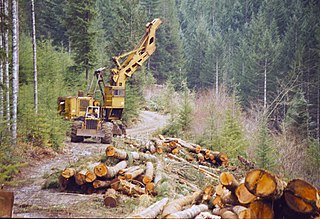 W
WCable logging, also referred to as skyline logging, is a logging method primarily used on the West Coast of North America with yarder, loaders, and grapple yarders, but also in Europe.
 W
WA cant hook or cant dog is a traditional logging tool consisting of a wooden lever handle with a movable metal hook called a dog at one end, used for handling and turning logs and cants, especially in sawmills. A peavey or peavey hook is similar, but has a spike in the end of the handle, whereas a cant dog has a blunt end or possibly small teeth for friction.
 W
WA forwarder is a forestry vehicle that carries big felled logs from the stump to a roadside landing. Unlike a skidder, a forwarder carries logs clear of the ground, which can reduce soil impacts but tends to limit the size of the logs it can move. Forwarders are typically employed together with harvesters in cut-to-length logging operations.
 W
WThe go-devil was a simple one-horse sled used for hauling trees in logging. Ralph C. Bryant describes it in his pioneering textbook Logging (1913) as follows: The go-devil is a product of the camp blacksmith shop. It is a rough sled having two unshod hardwood runners, which are preferably of yellow birch, selected from timbers having a natural crook. The usual type of runner is from 6 to 7.5 feet long, 6 inches wide, and from 3 to 5 inches thick. A 6-inch by 6-inch by 4-foot or 5-foot bunk is fastened to each runner by a bolt. The bunk is placed from 2 to 2.5 feet from the rear end of the runners. A ring is attached to the center of this bunk and the logs are bound on the latter by a chain passing around the logs and bunk and through the ring. The curved, forward ends of the runners are connected by a roller which has a short chain at each end that passes through a hole in the forward end of the runner and is fastened several inches back on it. Since the go-devil has no tongue it can be turned around in a small space. The draft rigging consists of chains fastened to either side of the bunk or to the runners. The chains are brought forward and joined directly in front of the roller by a ring to which the hook on the double-tree is attached. Since go-devils are loosely constructed, there is considerable backward and forward play in the runners and if one of them becomes obstructed the other moves ahead and starts it. Go-devils are seldom used for distances less than 300 feet, except under adverse snaking conditions. They may be used for a quarter of a mile on snow but are not as economical as larger sleds for this distance. Trails are required and these are cut by the swampers as they prepare the logs for skidding.
 W
WA grapple is a hook or claw used to catch or hold something. A ship's anchor is a type of grapple, especially the "grapnel" anchor.
 W
WHeli-logging, or helicopter logging, is a method of logging that uses helicopters to remove cut trees from forests by lifting them on cables attached to a helicopter. Helicopter logging is often used in inaccessible areas of forests. Because the use of helicopters reduces the level of infrastructure required to log in a specific location, the method also helps to reduce the environmental impact of logging. It also can increase the productivity in these remote areas.
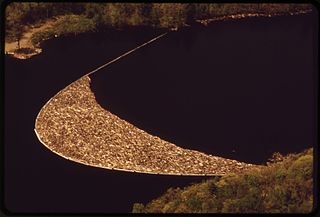 W
WA log boom is a barrier placed in a river, designed to collect and or contain floating logs timbered from nearby forests sometimes called a fence or bag. The term is also used as a place where logs were collected into booms, as at the mouth of a river. With several firms driving on the same stream, it was necessary to direct the logs to their owner's respective booms, with each log identified by its own patented timber mark. One of the most well known logbooms was in Williamsport, Pennsylvania, along the Susquehanna River. The development and completion of that specific log boom in 1851 made Williamsport the "Lumber Capital of the World".
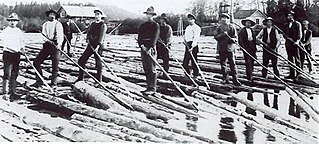 W
WLog driving is a means of moving logs from a forest to sawmills and pulp mills downstream using the current of a river. It was the main transportation method of the early logging industry in Europe and North America.
 W
WA log flume is a flume specifically constructed to transport lumber and logs down mountainous terrain to a sawmill by using flowing water. These watertight trough-like channels could be built to span a long distance across chasms and down steep mountain slopes. The use of log flumes facilitated the quick and cheap transportation of logs and thereby eliminated the need for horse- or oxen-drawn carriages on dangerous mountain trails.
 W
WLog Pond Cove is a former log pond and scenic wayside on the Connecticut River, about half a mile upstream from the Holyoke Dam at South Hadley Falls. The 18.5-acre (75,000 m2) pond was once used for ice cutting, as well as log drives from points north, diverted there in the late 19th and early 20th century. The log boom once set up there supplied contractors and the paper mills of Holyoke's industrial economy. After the last of these logging drives in 1915, silt gradually began to fill in the cove, gradually changing its river island border into a peninsula. By the mid-20th century the water body and its immediate surroundings had been acquired by the Holyoke Water Power Company, and in 1987 the site was briefly considered for use as the site of a children's nature camp. In 1998 it was recorded as the first body of water in the Connecticut River watershed to become infested with water chestnut, an invasive species that, despite efforts by Federal and local authorities, has persisted since that time. The area was acquired by Holyoke Gas & Electric as part of the dam and canal network on December 14, 2001, and is presently managed in part by US Fish and Wildlife Service staff and volunteers as an extension of the Silvio O. Conte National Fish and Wildlife Refuge. Today the cove is surrounded by 62 acres of undeveloped wetlands and functions as a sanctuary to many bird species, including great blue herons and several duck species.
 W
WThe Onega Tractor Plant or Onezhskiy Tractor Plant is a major Russian machine-building manufacturing plant in Petrozavodsk, Karelia, Russia.
 W
WThe Ottawa River timber trade, also known as the Ottawa Valley timber trade or Ottawa River lumber trade, was the nineteenth century production of wood products by Canada on areas of the Ottawa River destined for British and American markets. It was the major industry of the historical colonies of Upper Canada and Lower Canada and it created an entrepreneur known as a lumber baron. The trade in squared timber and later sawed lumber led to population growth and prosperity to communities in the Ottawa Valley, especially the city of Bytown. The product was chiefly red and white pine. The industry lasted until around 1900 as both markets and supplies decreased.
 W
WA cant hook or cant dog is a traditional logging tool consisting of a wooden lever handle with a movable metal hook called a dog at one end, used for handling and turning logs and cants, especially in sawmills. A peavey or peavey hook is similar, but has a spike in the end of the handle, whereas a cant dog has a blunt end or possibly small teeth for friction.
 W
WPointer boats were designed by John Cockburn and built by John, his son and grandson, from the 1850s to 1969. This historical boat was used in logging and had a very influential impact on the industry. The boat was the "workhorse" of the Canadian river system and was famous for being able to "float on a heavy dew". They assisted loggers to move Eastern White Pine timber down the wider sections of the Ottawa River.
 W
WThe St. Croix Boom Site is a historic and scenic wayside on the St. Croix River in Stillwater Township, Minnesota, United States. It commemorates the location of a critical log boom where, from 1856 to 1914, timber from upriver was sorted and stored before being dispatched to sawmills downstream. The site was developed as a roadside park along Minnesota State Highway 95 in the 1930s. In 1966 it was designated a National Historic Landmark for its national significance in the theme of industry. It was nominated for being the earliest, most important, and longest serving of the log storage and handling operations that supported Minnesota's major logging industry. Virtually no traces remain of the site's original buildings and structures.
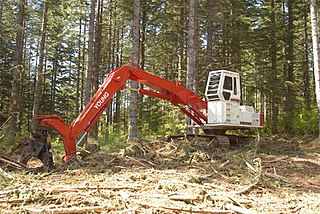 W
WShovel logging, sometimes called Hoe Chucking, uses a log loader to swing logs to the forest road. Shovel logging is one of a number of methods that may be used to move logs from forest to road. Rather than driving out to the log and dragging it back to the landing, the loader moves slowly across the harvest area, grabbing logs/trees within reach, and swinging them around to drop them closer to the road. Logs further from the road can be shoveled to the landing in a few passes back and forth.
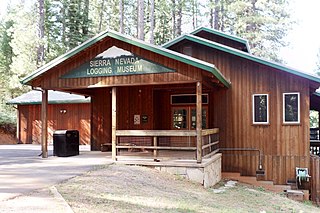 W
WThe Sierra Nevada Logging Museum is a museum dedicated to preserving the history of logging in the Sierra Nevada region. The museum is located on California State Route 4 in the Stanislaus National Forest, near Arnold, in Calaveras County, California, United States.
 W
WA skidder is any type of heavy vehicle used in a logging operation for pulling cut trees out of a forest in a process called "skidding", in which the logs are transported from the cutting site to a landing. There they are loaded onto trucks, and sent to the mill. One exception is that in the early days of logging, when distances from the timberline to the mill were shorter, the landing stage was omitted altogether, and the "skidder" would have been used as the main road vehicle, in place of the trucks, railroad, or flume. Modern forms of skidders can pull trees with a cable/winch, just like the old steam donkeys, or a grapple or a clam-bunk.
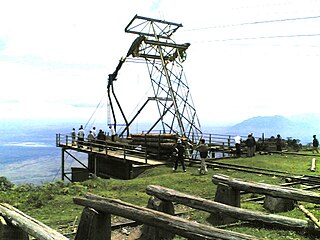 W
WSkyline logging is a form of cable logging in which harvested logs are transported on a suspended steel cable from where the trees are felled to a central processing location.
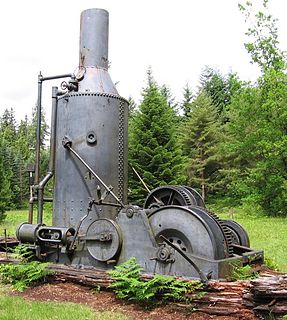 W
WSteam donkey, or donkey engine, is the name for a steam-powered winch widely used in past logging, mining, maritime, and other industrial applications.
 W
WA swing yarder is a mobile piece of heavy duty forestry equipment used for pulling logs from the woods to a logging road with cables. The swing yarder is also known as a grapple yarder.
 W
WTimber rafting is a method of transporting felled tree trunks by tying them together to make rafts, which are then drifted or pulled downriver, or across a lake or other body of water. It is arguably, after log driving, the second cheapest means of transporting felled timber. Both methods may be referred to as timber floating.
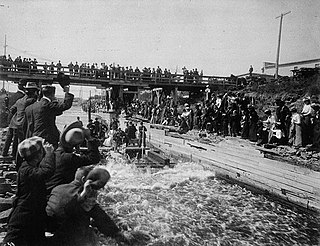 W
WA timber slide is a device for moving timber past rapids and waterfalls. Their use in Canada was widespread in the 18th and 19th century timber trade. At this time, cut timber would be floated down rivers in large timber rafts from logging camps to ports such as Montreal and Saint John, New Brunswick. Rapids and waterfalls would, however, damage the wood and could potentially cause log jams. Thus at these locations timber slides were constructed. These were thin water filled chutes that would run parallel to the river. They would usually only be wide enough for a single log and one at a time the logs would be directed down it. The idea is attributed to Ruggles Wright who introduced the first one in 1829 not far from what is today down-town Hull, Quebec, Canada. Later, the slides could often be up to a kilometre in length. They were most commonly found on the Ottawa River system.
 W
WTimberjack is a manufacturer of forestry machinery for both cut-to-length and whole tree logging, and was a subsidiary of John Deere from 2000 to 2006.
 W
WA yarder is piece of logging equipment which uses a system of cables to pull or fly logs from the stump to the landing. It generally consists of an engine, drums, and spar, but has a range of configurations and variations such as the swing yarder.